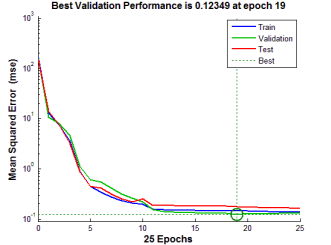Neural Network Modeling for The Microfiltration Process of Bacteria Harvesting From Fermentation Liquid
Keywords:
neural network, microfiltration, bacteriaAbstract
Microfiltration is considered useful processes in the field of food industry separation. In the present study, neural network modeling for laboratory data was performed using a ceramic microfiltration membrane to isolate Kocuria rhizophila bacteria from the feed stream. The independent parameters of this process are the back pressure of the membrane, speed of the current entering the membrane, contact time, and the dependent parameter of the flux passing through the membrane. The neural network used was a multilayer perceptron (MLP) system. The data are divided into three main parts of education, validation, and evaluation with a distribution percentage of 15-15-70. The variable of the number of hidden layer neurons in this study was changed from 1 to 20, and the value of 17 neurons was selected as the optimal number according to the results. for verify the prediction performance of the data in the neural network, two basic parameters of the determination coefficient (R2, mean square error (MSE)) were used. The R2 values for the training data, validation, evaluation, and all data using the learning function and the optimal transfer function of Levenberg-Marquardt and Tansing were 0.9995, 0.99966, 0.999111, and 0.9994, respectively. In addition, an MSE value of 0.008 was obtained, indicating a very low error rate. The results show that the neural network used and the optimal function obtained had the least errors in the data calculations and predictions.
References
Ahmad Kamaroddin, Mohd Fadhzir,Nordin Sabli., ``Membrane-based electrolysis for hydrogen production``: A review. Membranes,vol.11, issue.11, pp.810, 2021.
Dahiya, D., M. Kumar, G. Pugazhenthi, ``Separation of bacteria Kocuria rhizophila from fermentation broth by cross-flow microfiltration using inexpensive tubular ceramic membrane``. Arabian Journal for Science and Engineering, vol.47, issue.5, pp.5767-5776, 2020.
Asghari, Morteza, Amir Dashti, Mashallah Rezakazemi, ``Application of neural networks in membrane separation``. Reviews in Chemical Engineering,vol.36, issue.2, p. 265-310, 2020.
Anis, Shaheen Fatima, Raed Hashaikeh, and N. Hilal, ``Microfiltration membrane processes: A review of research trends over the past decade `` Journal of Water Process Engineering,vol.32, pp.100941, 2019.
Chellam, S., ``Artificial neural network model for transient crossflow microfiltration of polydispersed suspensions``. Journal of Membrane Science,vol.258, issue.1-2, p. 35-42, 1995.
Ren, Liumo, Shuili Yu, ``Pilot study on the effects of operating parameters on membrane fouling during ultrafiltration of alkali/surfactant/polymer flooding wastewater: Optimization and modelling``. RSC advances, vol.9, issue.20, pp.11111-11122, 2019.
Gul, A., J. Hruza, and F. Yalcinkaya, ``Fouling and chemical cleaning of microfiltration membrane``s: A mini-review. Polymers, vol.13, issue.6, pp. 846, 2021.
Azizi, N., M. Rezakazemi, and M.M. Zarei, ``An intelligent approach to predict gas compressibility factor using neural network model``. Neural Computing and Applications, vol.31, issue.1, pp. 55-64, 2019.
El-Ghaffar, M. and H.A. Tieama, ``A review of membranes classifications, configurations, surface modifications, characteristics and Its applications in water purification``.Chemical and Biomolecular Engineering, , vol.2, issue.2, pp. 57-82, 2017.
Luis, P. and B. Van der Bruggen, ``Pervaporation modeling: State of the art and future trends``. Pervaporation, Vapour Permeation and Membrane Distillation, pp. 87-106, 2015.
Changmai, M., M. Pasawan, and M. Purkait, ``Treatment of oily wastewater from drilling site using electrocoagulation followed by microfiltration``. Separation and purification Technology, vol.21, pp. 463-472, 2019.
Madaeni, S., N.T. Hasankiadeh, and H. Tavakolian, ``Modeling and optimization of membrane chemical cleaning by artificial neural network, fuzzy logic, and genetic algorithm``. Chemical Engineering Communications, vol.199, issue.3, pp. 399-416, 2012.
Chellam, Shankararaman. "Artificial neural network model for transient crossflow microfiltration of polydispersed suspensions." Journal of Membrane Science, vol.258, issue.1-2, pp. 35-42, 2005.
Liu, Yuanfa, Gaohong He, Ming Tan, Fei Nie, and Baojun Li. "Artificial neural network model for turbulence promoter-assisted crossflow microfiltration of particulate suspensions." Desalination, vol.337, pp. 57-64, 2014.

Downloads
Published
How to Cite
Issue
Section
License

This work is licensed under a Creative Commons Attribution 4.0 International License.
Authors contributing to this journal agree to publish their articles under the Creative Commons Attribution 4.0 International License, allowing third parties to share their work (copy, distribute, transmit) and to adapt it, under the condition that the authors are given credit and that in the event of reuse or distribution, the terms of this license are made clear.





